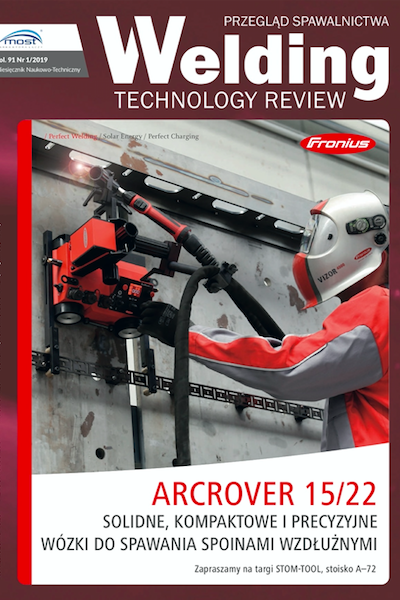The influence of the cooling method on shortening the cycle of multi-layer arc-surfacing of thin walls
##plugins.themes.bootstrap3.article.main##
Abstrakt
The use of 3D printing methods in the industry is becoming more frequent and popular. It brings specific economic effects, enables quick and precise production of machine parts and devices. The article presents a fragment of research carried out in the Welding Engineering Department of the Warsaw University of Technology on the application of MAG arc welding for 3D printing. The MAG method was used to try to produce thin walls. The aim of the presented research was to determine the effect of the cooling method on shortening the time of manufacturing the 3D model of thin walls. The models were made using G3Si1 and 316LSi electrode wires. In the first part of the research,an interpass temperature of 50 °C, 100 °C and 150 °C, achieved by free cooling was adopted. In the second part, the interpass temperature was 100 °C and was achieved by forced cooling with a copper plate, a fan and a stream of compressed air. The greatest reduction in the time of manufacturing the 3D model of a thin wall was obtained for cooling using compressed air.
Pobrania
##plugins.themes.bootstrap3.article.details##
Creative Commons CC BY 4.0 https://creativecommons.org/licenses/by/4.0/
Artykuły czasopisma Welding Technology Review (Przegląd Spawalnictwa) publikowane są w otwartym dostępie na licencji CC BY (licencja Creative Commons Uznanie autorstwa 4.0 Międzynarodowe). Licencja CC BY jest najbardziej otwartą dostępną licencją i uważaną za „złoty standard” w formule otwartego dostępu; jest również preferowany przez wielu fundatorów badań. Licencja ta umożliwia czytelnikom kopiowanie i redystrybucję materiału na dowolnym nośniku i w dowolnym formacie, a także zmienianie, przekształcanie lub budowanie na nim materiału, w tym do użytku komercyjnego, pod warunkiem wskazania oryginalnego autora.
Bibliografia
P. Siemiński, G. Budzik, Techniki przyrostowe. Druk 3D. Drukarki 3D, Oficyna Wydawnicza Politechniki Warszawskiej, Warszawa (2015).
P.M. Dickens, R. Cobb, I. Gibson, M.S. Pridham, Rapid Prototyping Using 3D Welding, Journal of Design and Manufacturing (1993), 3.
Z. Wang; T.A. Palmer; A.M. Beese, Effect of processing parameters on microstructure and tensile properties of austenitic stainless steel 304L made by directed energy deposition additive manufacturing, Acta Materialia (2016), 110, 226-235.
T.E. Abioye, A. Medrano-Telllez, P.K. Farayibi, P.K. Oke, Laser metal deposition of multi-track walls of 308LSi stainless steel, Materials and Manufacturing Processes (2017), vol. 32 (14), 1660-1666, DOI: 10.1080/10426914. 2017.1292034.
P. Cegielski, Nowe obszary zastosowania napawania łukowego MIG/ MAG, Welding Technology Review (2016), vol. 88 (6), 48-49.
P.Cegielski,A.Skublewska,P.Gawroński,M.Ostrysz,M.Dylewski,M.Ga- jowniczek, Zastosowanie napawania łukowego MIG/MAG do drukowania 3D, Spajanie (2016), 2, 22-26.
P. Cegielski, M. Ostrysz, W. Łacisz, M. Panas, P. Kowalski, Nowe prace nad wykorzystaniem napawania łukowego MIG/MAG do drukowania 3D,Welding Technology Review (2018) vol. 89 (1), 43-47.
S. Selvi, A. Vishvaksenan, E. Rajasekar, Cold metal transfer (CMT) technology An overview, Defence Technology (2018), vol. 14 (1), 28-44.
W. Łacisz, Intensyfikacja wytwarzania cienkich ścian na drodze wielowarstwowego napawania łukowego. Praca dyplomowa inżynierska, Politechnika Warszawska, Warszawa (2018).
